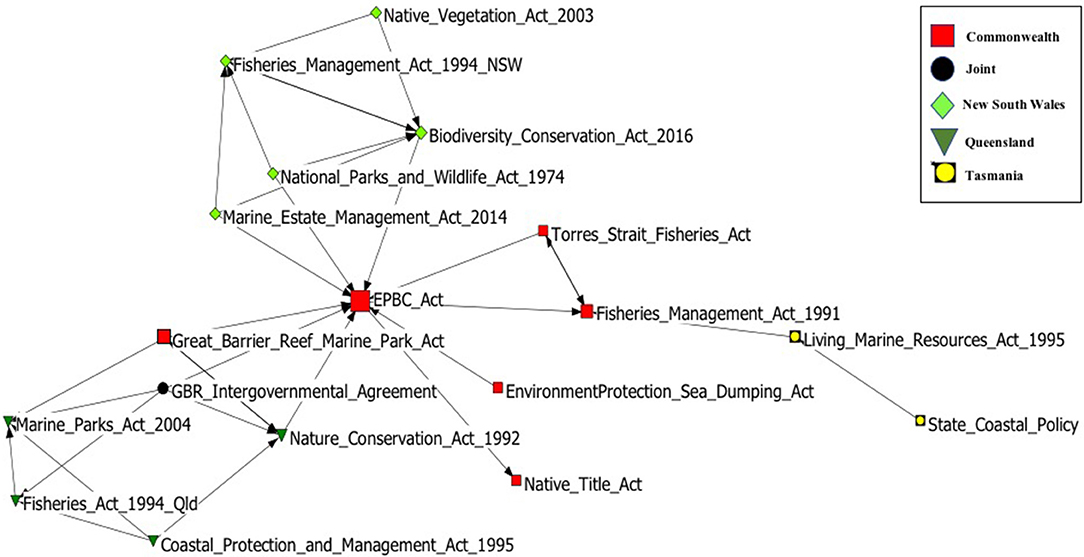Protecting Migratory Species in the Australian Marine Environment: A Cross-Jurisdictional Analysis of Policy and Management Plans
- Department of Marine Biology and Aquaculture, College of Science and Engineering, James Cook University, Townsville, QLD, Australia
A Corrigendum on
Protecting Migratory Species in the Australian Marine Environment: A Cross-Jurisdictional Analysis of Policy and Management Plans
by Miller, R. L., Marsh, H., Cottrell, A., and Hamann, M. (2018) Front. Mar. Sci. 5:229. doi: 10.3389/fmars.2018.00229
In the original article, there was a mistake in Table 1 as published. Conservation Advices and Wildlife Conservation Plans were originally listed in Table 1 as non-statutory; this was incorrect. Conservation Advices and Wildlife Conservation Plans are statutory under the Environment Protection and Biodiversity Conservation Act 1999; however, the consideration of these plans that the Minister must take when approving decisions differs from a Recovery Plan (Table B2 in Supplementary Material). The corrected Table 1 appears below. In addition a correction has been made to the final sentence of Discussion, Coherence within Australia, paragraph 4:

Table 1. The EPBC listing of the four case studies in Australia chosen for this study, their respective national management plans, and the primary species-specific instrument (national) for mitigating threats for each case study.
The disconnect between policies and management plans can be problematic for managing species as many types of plans are not statutory. Management plans are often drafted as a form of threat mitigation rather than conservation, and non-statutory plans will have less of an impact on conservation than explicit environmental policy. Only recovery, protected area management, conservation advices, conservation plans, and threat abatement plans are statutory under the EPBC Act 1999 (see Table B2 in Appendix B for descriptions). In addition, several recovery plans have expired under the EPBC Act 1999 and are being replaced with conservation advices in order to address the backlog of recovery plans. The disadvantage of this is that conservation advices hold less weight than recovery plans when the Minster is making a decision regarding approving anthropogenic activities.
Figure 3 attributes the Great Barrier Reef Marine Park Act 1975 as a joint Act; this Act is actually Commonwealth legislation. Figure 3 has been updated accordingly.

Figure 3. The connectedness of environmental policies from multiple levels of governance (symbols represent location) in Australia. Reviewed Victorian legislation is excluded as no policies connected with the reviewed policies of any other jurisdiction or within Victoria. Node position is based on centrality within the network; the EPBC Act 1999 has the most connections and is the central link for policies within Australia. Node size is based on betweenness – larger nodes serve as a pathway for more policies. Relationships between policies are directional—the arrow points from one policy to another where a relationship has been identified.
The title of the Recovery Plan is missing from the second paragraph of the Results Section: Coherence Within Australia. In the Results Section: Coherence Within Australia, paragraph 2, the paragraph should read:
The relationships between policies and management plans was more developed than the relationships between policies, with 106 plans identifying a connection to one or more environmental policies. Twenty-three of the federal plans relate to federal policies, 56 state plans identify relationships to federal policies, and 71 state plans refer to policies within that same state. Only two plans, the Australia Pacific LNG Upstream Project: Pipeline Threatened Fauna Management Plan (industry-generated environmental management plan) and the Recovery Plan for Marine Turtles in Australia 2017, operated under multi-state legislation. Despite being jointly made by the relevant federal, Qld, and NSW ministers, the Recovery Plan for Marine Turtles in Australia 2017 demonstrated little connection to legislation from Qld and NSW (Figure 4A).
Clarifications
In addition, we have clarified two points in order to provide greater context to the readers.
1) In Table 1, the reason we have listed marine turtles as “threatened” and humpback whales as “vulnerable” is because the six species of marine turtles found in Australia do not all share the same threatened listing under the Environment Protection and Biodiversity Conservation Act 1999 (e.g., loggerheads are listed as endangered and hawksbills are listed as vulnerable). Humpback whales are listed as vulnerable, which also means they are considered to be threatened in Australia under the EPBC Act 1999.
2) In Results: Relevance of Environmental Policies and Management Plans in Australia, we use the word “protected.” The use of this word is to refer to species listed as “protected” under federal and state legislation; some of these species are also considered to be threatened in that jurisdiction.
The authors apologize for these errors and state that these do not change the scientific conclusions of the article in any way.
The original article has been updated.
Conflict of Interest Statement
The authors declare that the research was conducted in the absence of any commercial or financial relationships that could be construed as a potential conflict of interest.
Keywords: policy evaluation, policy coherence, marine migratory species, Matters of National Environmental Significance, marine governance
Citation: Miller RL, Marsh H, Cottrell A and Hamann M (2018) Corrigendum: Protecting Migratory Species in the Australian Marine Environment: A Cross-Jurisdictional Analysis of Policy and Management Plans. Front. Mar. Sci. 5:315. doi: 10.3389/fmars.2018.00315
Received: 14 August 2018; Accepted: 15 August 2018;
Published: 05 September 2018.
Approved by:
Frontiers in Marine Science Editorial Office, Frontiers Media SA, SwitzerlandCopyright © 2018 Miller, Marsh, Cottrell and Hamann. This is an open-access article distributed under the terms of the Creative Commons Attribution License (CC BY). The use, distribution or reproduction in other forums is permitted, provided the original author(s) and the copyright owner(s) are credited and that the original publication in this journal is cited, in accordance with accepted academic practice. No use, distribution or reproduction is permitted which does not comply with these terms.
*Correspondence: Rachel L. Miller, rachel.miller3@my.jcu.edu.au
 Rachel L. Miller
Rachel L. Miller Helene Marsh
Helene Marsh Mark Hamann
Mark Hamann